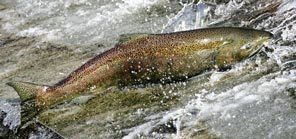forum
library
tutorial
contact

Scientists Light the Way on
Columbia River Hatchery Reform
by Jim WaldoSeattle Times, April 23, 2009
|
the film forum library tutorial contact |

|
Scientists Light the Way on
by Jim Waldo |
Finally, a scientific consensus has emerged about how to improve Columbia River basin hatcheries to enhance recovery efforts for salmon. Now, Northwest leaders should translate that consensus to results in the water.
 OPPORTUNITIES are opening up to speed recovery of Columbia wild salmon runs, increase our return on investment in habitat restoration
-- and catch more fish. That might sound like a fish story, but it's not only true, it's an opportunity our region's leaders need to seize.
OPPORTUNITIES are opening up to speed recovery of Columbia wild salmon runs, increase our return on investment in habitat restoration
-- and catch more fish. That might sound like a fish story, but it's not only true, it's an opportunity our region's leaders need to seize.
Over the past three years, a group of scientists called the Hatchery Scientific Review Group (HSRG) studied 178 salmon and steelhead hatchery programs in the Columbia River basin, along with 351 counterpart natural populations. The group's mandate from Congress was to recommend ways for hatcheries to help conserve wild populations and to support sustainable fisheries. The HSRG brought together an international, independent group of scientists who saw their role as providing constructive solutions, not just identifying problems.
The review group not only reviewed and recommended many reforms to hatchery practices, the scientists also evaluated the role of new harvest strategies and the condition of habitat for each population. Their findings form a clear and remarkably compelling road map for all parties interested in the future of salmon in the Columbia.
One key finding builds on something scientists have long understood -- that local adaptation to their natural environment is critical to higher rates of spawning success, and that over time, hatchery fish became much more uniform in their genetic makeup and adapted to the hatchery environment. As a result, some hatchery fish are up to 50 percent less productive when spawning in the wild than their natural counterparts.
Moreover, genetic diversity appears to be critical to the overall survival strategy for salmon. So the sooner we adapt our hatchery programs to these realities the better. For the first time on such a large scale, the review group examined how every hatchery serves -- or does not serve -- goals for wild fish in every watershed in light of the condition of wild stocks, available habitat and harvest goals.
Implementing the recommendations for reforms in hatcheries and harvest, the scientists found, could double the effectiveness of investments in restoring habitat. As well, by changing to harvest methods and locations that minimize impacts to wild fish, fishers can take more hatchery fish than is possible now while also reducing the chance of hatchery fish spawning in the wild and increasing natural spawners.
Increasing the genetic diversity of hatchery populations and changing harvest methods to conserve more wild fish will be major biological and political undertakings. Fortunately, all the major players -- tribes, federal and state fisheries managers, scientific and conservation agencies, the Bonneville Power Administration (Bonneville is a major funder of Columbia River Basin hatcheries), and interest groups -- support the Habitat Scientific Review Group effort and embrace most, if not all, its recommendations.
Leadership is stepping up. U.S. Sen. Patty Murray, D-Wash., has been a leader in this effort and Congressman Norm Dicks, D-Bremerton, has promised to pursue appropriations to renovate badly run-down federal hatcheries on the Lower Columbia. Washington state has made a difficult decision to close a hatchery on the lower river and jointly developed, with Oregon, a plan to shift production of chinook and coho that will benefit fishers in both states while meeting conservation and recovery objectives. Tribes have taken leadership roles as well.
The Yakama Nation has been experimenting with enhancing natural production of wild runs. Further upstream, the Colville Confederated Tribes have been trying new harvest methods that would allow release of wild salmon. The Northwest Power and Conservation Council is considering incorporating the scientific review group approach into its regional fish and wildlife program.
The issue for most is not will, but money. While some of these recommendations are relatively cheap, others are not. It will take a sustained effort over some number of years and millions of dollars to achieve these benefits. But cost is relative -- especially given the significant investments that have been made and will be made in fish passage and improved fish habitat. The key here is that the science shows that investments in hatchery and harvest reforms have a high and rapid payback, in stronger wild fish, more productive use of habitat and better harvests.
Our regional congressional delegation would be wise to quickly transfer the scientific and political consensus into results in the water. Taxpayers, ratepayers, fishers and their future generations will thank them.
learn more on topics covered in the film
see the video
read the script
learn the songs
discussion forum
